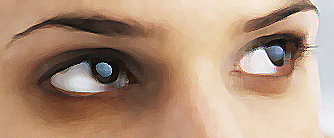Treating Those Dark Circles Under the Eyes

There are probably as many different remedies for dark circles under the eyes as there are people on earth. In my experience, when many treatments exist for the same problem, most of them are not terribly successful. Most large cosmetics companies and not a few pharmaceutical companies have been wrestling with this problem for years behind armies of scientists and physicians. With such powerful combinations of smarts and funding, why hasn’t the problem been solved?
Part of the answer lies in my last entry, which dealt with some of the major causes of dark circles. The best treatment for any problem is to cure its cause. While covering up dark circles with techniques described here certainly addresses the issue, the problem and its causes remain. Because dark circles under the eyes may result from a variety of etiologies ranging from allergies to sun exposure to heredity, no single cure-all exists to treat all of them. Therefore, the first step to get rid of dark circles is to determine the cause. A visit to your physician may provide invaluable insight to get you started.
Keeping a log or journal can also help you (and your doctor) understand the causes of your dark circles. For example, if your eyes are puffy on days after getting too little sleep or having a salty meal, creating a shadow/line below the eyes, then simple lifestyle changes may help. If your eyes are worst during spring allergy season, taking an antihistamine may provide significant improvement.
But the most common culprit causing chronic dark circles is excess pigmentation in the skin. Although this problem is prevalent among all skin colors and types, it is especially troublesome for Asians, African-Americans, and those of Mediterranean descent. Too much sun exposure makes the circles darker.
Another common cause is thinning skin with dilated blood vessels underneath, leading to the purplish appearance. Aging, which causes skin to thin, can therefore lead to progressively darker circles beneath the eyes. And medications such as birth control pills, which can dilate blood vessels, may add to the problem.
Too much skin pigmentation, something physicians refer to as hyperpigmentation, is often treated with a product containing hydroquinone. Differing concentrations of this product are available by prescription or in nonprescription forms. Sometimes, these are coupled with other medications focused on increasing skin thickness as well. It has also been used with tretinoic acid to increase its efficacy. Hydroquinone in low concentrations is reasonably safe, but side effects are known to occur, including contact dermatitis (an allergic reaction in the skin). Be sure to consult your doctor before using any medication. If you have a history of liver or kidney disease, let your physician know. If you are pregnant, or breast-feeding, I recommend that you do not use hydroquinone or tretinoic acid.
Other products for skin pigmentation are hydroquinone free. One such product is Vivite Vibrance Therapy, which boasts natural ingredients including retinols, a natural botanical, glycol compounds, and anti-oxidants such as mulberry fruit and licorice root extracts. While all skin-lightening agents are used for more than just the dark circles under the eyes, they can provide dramatic improvement in cases where hyperpigmentation is the cause of the dark circles.
Remember that you may have several different reasons for those dark circles. For example, a combination of sleepless nights, allergies, and too much sun might be causing circles, and addressing just one or two of the causes will not fully eliminate the problem.
And finally, another common cause of dark circles under the eyes is the shadowing created by a combination of bags under the eyes and the downward fall of the cheek pads from the inexorable pull of gravity. In order to treat these lines, a visit to your facial plastic surgeon can provide answers ranging from a quick filler injection to lower eyelid (eye bag) surgery and even a midface lift to raise the cheeks back to their youthful position. I’ll explore these options in my next

